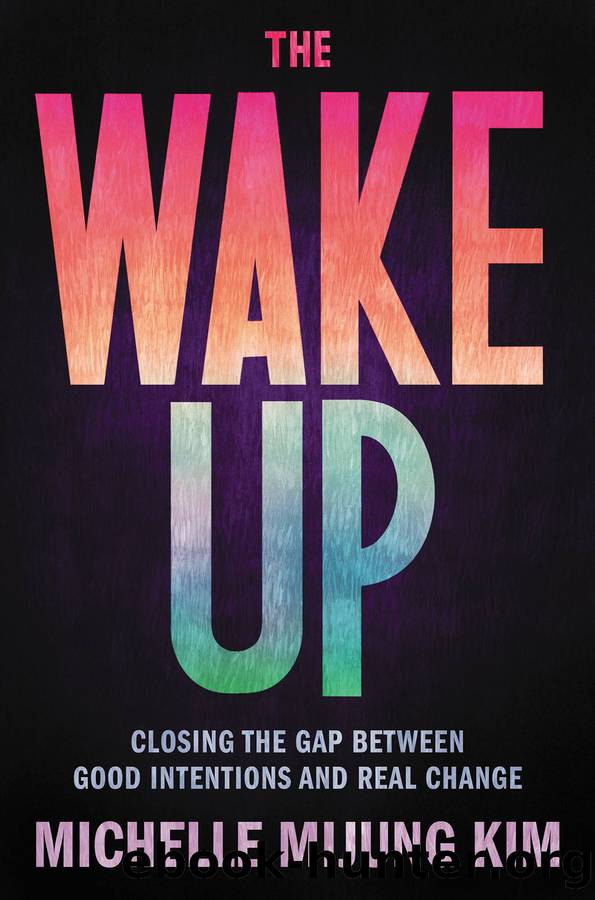The Wake Up: Closing the Gap Between Good Intentions and Real Change by Michelle MiJung Kim

Author:Michelle MiJung Kim [Kim, Michelle MiJung]
Language: eng
Format: epub
ISBN: 9780306847202
Google: 4MIizgEACAAJ
Publisher: Hachette Books
Published: 2021-09-28T00:24:10.081522+00:00
THE FIVE PRINCIPLES OF INCLUSIVE LANGUAGE
Rather than providing a static list of the latest terms (the what), which may become quickly outdated or be used out of context, here are five foundational principles (the why and the how) to help navigate language in a thoughtful, adaptive way.
1. Use the Most Universally Inclusive Language
We begin the practice by first identifying language that inadvertently, or sometimes purposely, alienates others, and consciously decide to broaden our scope of language to include historically excluded and marginalized people. Common examples in this practice are using nongendered language when addressing groups of people, like âhi team,â âgreetings everyone,â and âwelcome folksâ instead of âladies and gentlemenâ or âhey guys.â There has also been a movement to use gender-neutral terms when describing occupations (e.g., congressperson versus congressman/woman, firefighter versus fireman, etc.), products that can be used by multiple genders (e.g., menstrual product versus feminine product), and not equating body parts to gender identities (e.g., people who menstruate versus womenâbecause folks with different gender identities, like trans men, nonbinary people, and genderqueer people, can menstruate too), while normalizing the use of the singular they pronoun rather than defaulting to pronouns that reinforce the gender binary (he or she). Inside companies, there have been calls to shift ableist language, such as company all-hands being replaced with company-wide meeting, or daily stand-up with daily check-in. Exclusionary language sends overt and subtle signals that certain people do not belong in certain spaces, that their existence is not valuable enough to be acknowledged even in something as flexible as the language we use. Using and maintaining harmful language is the gateway to perpetuating more harmful patterns, while replacing exclusionary language with universally inclusive language helps disrupt that by neutralizing the underlying bias.
Being able to use the most universally inclusive language requires us to train ourselves to recognize when certain terms and language we use are exclusionary in the first place. Terms and phrases that are rooted in oppressive history or cultural appropriation are difficult to spot without additional knowledge and awareness, so continuing to educate ourselves and proactively seeking out resources is important. For example, it wasnât that long ago that I learned the problematic history behind grandfathered in, a phrase I had become accustomed to using while working in the tech industry, widely used to describe contract terms or customers that were considered exempt from any new changes made. Little did I know that the phraseâs origin dates all the way back to the late nineteenth century. With the ratification of the Fifteenth Amendment in 1870, Black men were granted the right to voteâin theory. In reality, state requirements, such as literacy tests and poll taxes, were deliberately set as obstacles to disenfranchise the Black voter. To keep these same requirements from disenfranchising illiterate white men, a âgrandfather clauseâ was created in the 1890s in a number of southern states like North Carolina and Georgia that allowed men to vote on the basis of their lineal ancestorâs (i.e., grandfatherâs) ability to vote prior to 1867, effectively excluding Black voters.
Download
This site does not store any files on its server. We only index and link to content provided by other sites. Please contact the content providers to delete copyright contents if any and email us, we'll remove relevant links or contents immediately.
Zero to IPO: Over $1 Trillion of Actionable Advice from the World's Most Successful Entrepreneurs by Frederic Kerrest(4235)
Machine Learning at Scale with H2O by Gregory Keys | David Whiting(4113)
Never by Ken Follett(3767)
Harry Potter and the Goblet Of Fire by J.K. Rowling(3759)
Ogilvy on Advertising by David Ogilvy(3483)
Shadow of Night by Deborah Harkness(3278)
The Man Who Died Twice by Richard Osman(2981)
Book of Life by Deborah Harkness(2854)
Will by Will Smith(2772)
0041152001443424520 .pdf by Unknown(2771)
My Brilliant Friend by Elena Ferrante(2761)
How Proust Can Change Your Life by Alain De Botton(2726)
The Tipping Point by Malcolm Gladwell(2720)
Purple Hibiscus by Chimamanda Ngozi Adichie(2624)
How to Pay Zero Taxes, 2018 by Jeff A. Schnepper(2578)
Hooked: A Dark, Contemporary Romance (Never After Series) by Emily McIntire(2482)
Rationality by Steven Pinker(2273)
Borders by unknow(2214)
Can't Hurt Me: Master Your Mind and Defy the Odds - Clean Edition by David Goggins(2157)
